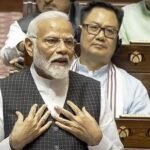In a captivating portrayal of the Hindu epic Ramayana, the stage at Sunder Nursery comes alive with the timeless tale of ‘Angad Ravan Samvaad’, where the prince of Kishkinda, Angad, confronts the mighty demon king Ravana, urging him to surrender before Lord Ram. The scene unfolds with the powerful declaration of Ravana, infused with the eloquence of Urdu, “Main woh Raavan hoon, jisse kaanpti hai saari khudai” (“I am that Ravana, who is feared by the entire divinity”), eliciting resounding applause from the audience.
‘Dastan-e-Ramayan: Ramleela in Urdu’ stands as a testament to the rich cultural tapestry of India, blending the essence of the Hindu epic with the poetic nuances of Urdu language. Organized as part of the four-day ‘Jashn-e-Urdu’ festival by the Delhi government’s Department of Art, Culture, and Language in collaboration with the Urdu Academy, Delhi, the event embodies the spirit of our composite Ganga-Jamuni culture.
Minister of Art, Culture, and Language Saurabh Bharadwaj emphasizes the government’s commitment to promoting inclusivity and diversity through such initiatives, which aim to spread the message of harmony and unity across communities.
Renowned personalities from the world of ghazals and Sufi music grace the festival, adding their melodic voices to the celebration of cultural exchange. The performance by the Nizami Brothers, Khannak Joshi, Talat Aziz, and Salman Ali enriches the tapestry of the event, captivating audiences with their soulful renditions.
As the theatrical spectacle unfolds, actors seamlessly weave Urdu phrases into their dialogues, infusing the narrative with depth and resonance. Words like “khumaar” (intoxication), “ghuruur” (pride), “fanaa” (destruction), and “maidan-e-jung” (battlefield) resonate with listeners, highlighting the universal themes embedded within the Ramayana.
Following the performance, a thought-provoking panel discussion titled “Ramayana in the Mirror of Urdu” engages scholars and enthusiasts alike, offering insights into the epic from the lens of the Urdu language. Scholars such as Khalid Alvi, Khalid Ashraf, and Mohammad Kazim delve into the nuances of the Ramayana, exploring its relevance and resonance in contemporary times.
Director Anil Chawla reflects on the journey of the theatre group, tracing its roots back to pre-partition India, where Ramlila served as a source of entertainment and community bonding. Today, the group embodies the spirit of inclusivity, with members from diverse backgrounds coming together to enact the timeless tale of Ramayana.
In a poignant testament to unity amidst diversity, Mr. Chawla emphasizes the importance of language as a bridge between communities, with both Hindus and Muslims contributing to the vibrant tapestry of the theatrical performance.
‘Dastan-e-Ramayan: Ramleela in Urdu’ transcends boundaries of language and culture, embodying the timeless message of love, righteousness, and harmony that resonates across generations. As the curtains draw to a close, the echoes of the epic reverberate, reminding us of the enduring power of storytelling to unite and inspire.









